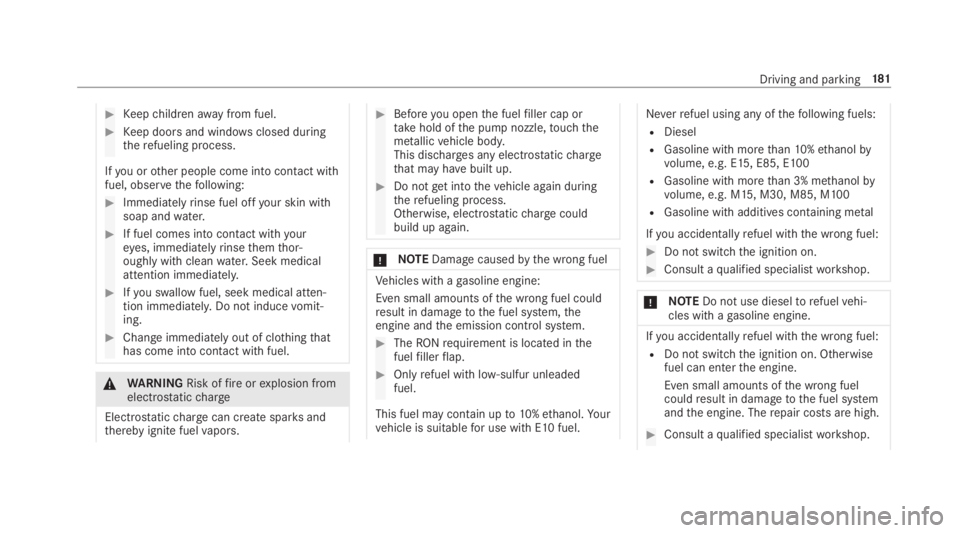water pump MERCEDES-BENZ S CLASS 2019 Owners Manual
[x] Cancel search | Manufacturer: MERCEDES-BENZ, Model Year: 2019, Model line: S CLASS, Model: MERCEDES-BENZ S CLASS 2019Pages: 578, PDF Size: 23.31 MB
Page 183 of 578

#Keepchildrenawayfrom fuel.
#Keep doors and windowsclosed duringtherefueling process.
Ifyou orother people come into contact withfuel, observethefollowing:
#Immediatelyrinse fuel offyour skin withsoap andwater.
#If fuel comes into contact withyoureyes, immediatelyrinsethemthor‐oughly with cleanwater.Seek medicalattention immediately.
#Ifyou swallow fuel, seek medical atten‐tion immediately.Do not inducevomit‐ing.
#Change immediately out of clothingthathas come into contact withfuel.
&WARNINGRisk offireorexplosion fromelectrostaticcharge
Electrostaticchargecan createsparksandthereby ignite fuelvapors.
#Beforeyou openthe fuelfiller cap ortakehold ofthe pump nozzle,touchthemetallicvehicle body.This discharges any electrostaticchargethat may havebuilt up.
#Do notget intothevehicle again duringtherefueling process.Otherwise, electrostaticchargecouldbuild up again.
*NOTEDamagecausedbythe wrong fuel
Vehicles with agasoline engine:
Even small amounts ofthe wrong fuel couldresult in damagetothe fuel system,theengine andthe emission control system.
#TheRONrequirement is located inthefuelfillerflap.
#Only refuel with low-sulfur unleadedfuel.
This fuel may contain upto10%ethanol.Yourvehicle is suitablefor use with E10 fuel.
Neverrefuel using any ofthefollowing fuels:
RDiesel
RGasoline with morethan10%ethanolbyvolume, e.g. E15, E85, E100
RGasoline with morethan 3% methanolbyvolume, e.g. M15, M30, M85, M100
RGasoline with additives containing metal
Ifyou accidentallyrefuel withthe wrong fuel:
#Do not switchthe ignition on.
#Consult aqualified specialistworkshop.
*NOTEDo not use dieseltorefuelvehi‐cles with agasoline engine.
Ifyou accidentallyrefuel withthe wrong fuel:
RDo not switchthe ignition on. Otherwisefuel can enterthe engine.
Even small amounts ofthe wrong fuelcouldresult in damagetothe fuel systemandthe engine. Therepair costs are high.
#Consult aqualified specialistworkshop.
Driving and parking181
Page 419 of 578

#Pushthe plug of hose5intoflange6oftire sealant bottle1untilthe plug engages.
#Place tire sealant bottle1head downwardsintorecess2ofthe tire inflation compres‐sor.
#Removethe cap fromvalve7onthefaultytire.
#Screwfilling hose8ontovalve7.
#Insert connector4into a12V socket inyourvehicle.
#Switch onthe ignition.
#Press on and off switch3onthe tire infla‐tion compressor.The tire inflation compressor is switched on.The tire is inflated. First, tire sealant is pum‐ped intothe tire. The pressure may brieflyrisetoapproximately 500 kPa (5 bar/73 psi).
Do not switch offthe tire inflation compres‐sor duringthis phase.
#Letthe tire inflation compressorrunfor amaximum of eight minutes.The tire shouldthen haveattained a tirepressure of at least180 kPa (1.8 bar/26 psi).
If tire sealant leaksout, make sureyou cleantheaffected area asquickly as possible. It is prefera‐bletouse clearwater.
Ifyouget tire sealant onyour clothing, haveitcleaned as soon as possible with perchloroethy‐lene.
If a tirepressure of180 kPa (1.8 bar/26 psi)has not been attained after eight minutes:
#Switch offthe tire inflation compressor.
#Unscrewthefilling hose fromthevalve ofthefaulty tire.
Please notethat tire sealant may leak out whenunscrewingthefilling hose.
#Driveforwards orreverseveryslowlyforapproximately 33ft(10 m).
#Pump upthe tire again.After a maximum of eight minutesthe tirepressure must be at least180 kPa (1.8 bar/26 psi).
&WARNINGRisk of accident duetothespecified tire pressure not beingreached
Ifthe specified tire pressure is notreachedafterthe specified time,the tire istoo badlydamaged. The tire sealant cannotrepairthetire inthis instance.
Damaged tires and a tire pressurethat istoolow can significantly impair braking and han‐dlingcharacteristics.
#Do not continue driving.
#Consult aqualified specialistworkshop.
Breakdown assistance417